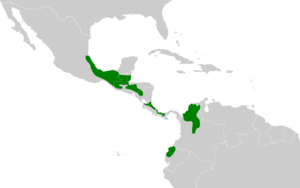Band-backed wren facts for kids
Quick facts for kids Band-backed wren |
|
|---|---|
 |
|
| Conservation status | |
| Scientific classification | |
| Genus: |
Campylorhynchus
|
| Species: |
zonatus
|
 |
|
The band-backed wren (Campylorhynchus zonatus) is a small songbird that belongs to the wren family. These birds live in many parts of Central America and northern South America.
You can find band-backed wrens from the Gulf Coast of Mexico all the way down to northwestern Ecuador. They live in five separate areas. One main area is in southern Central America, including Costa Rica and northern Panama. Other groups live in northern Colombia and further south in northwestern Ecuador.
Contents
About the Band-backed Wren
What They Look Like
The adult band-backed wren is about 16.5 cm (6.5 inches) long. It weighs around 29 g (1 ounce). Its head is brown-grey, and its neck is black. The rest of its back and tail have many black, tawny (brownish-orange), and white stripes.
Its chest and throat are white with many black spots. The belly is a cinnamon color. Young wrens have duller colors on their backs. Their undersides are off-white or light brown.
Where They Live
These wrens live in lowlands and hills. You can find them from sea level up to 1700 m (5,577 feet) high. They prefer thin forests, open woodlands, and bushy areas. They also live in places where new plants are growing, and in groves near houses.
Most band-backed wrens in Central America live on the Caribbean side of the mountains.
Their Sounds
The band-backed wren makes a short, scratchy sound, like "zek." Their song is a mix of dry chattering, spluttering, and gurgling noises.
What They Eat
Band-backed wrens are active birds. They often search for food in family groups of 4 to 12 birds. They mainly eat insects, spiders, and other small creatures without backbones, called invertebrates.
Nests and Young Birds
Band-backed wrens build large, round nests. These nests have a wide opening on the side. They are built high up in a tree or bush, from 2 to 30 m (6.5 to 98 feet) off the ground. Often, their nests are hidden among bromeliad plants.
The female wren lays three to five white eggs. These eggs might have a few light brown spots. She sits on the eggs alone for about two weeks until they hatch. The young birds leave the nest about two weeks after hatching. After the breeding season, families sleep together in these same nests all year long.


